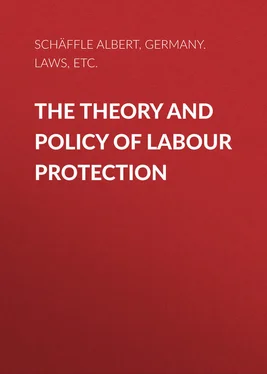Albert Schäffle - The Theory and Policy of Labour Protection
Здесь есть возможность читать онлайн «Albert Schäffle - The Theory and Policy of Labour Protection» — ознакомительный отрывок электронной книги совершенно бесплатно, а после прочтения отрывка купить полную версию. В некоторых случаях можно слушать аудио, скачать через торрент в формате fb2 и присутствует краткое содержание. Жанр: Юриспруденция, Юриспруденция, foreign_antique, foreign_prose, на английском языке. Описание произведения, (предисловие) а так же отзывы посетителей доступны на портале библиотеки ЛибКат.
- Название:The Theory and Policy of Labour Protection
- Автор:
- Жанр:
- Год:неизвестен
- ISBN:нет данных
- Рейтинг книги:5 / 5. Голосов: 1
-
Избранное:Добавить в избранное
- Отзывы:
-
Ваша оценка:
- 100
- 1
- 2
- 3
- 4
- 5
The Theory and Policy of Labour Protection: краткое содержание, описание и аннотация
Предлагаем к чтению аннотацию, описание, краткое содержание или предисловие (зависит от того, что написал сам автор книги «The Theory and Policy of Labour Protection»). Если вы не нашли необходимую информацию о книге — напишите в комментариях, мы постараемся отыскать её.
The Theory and Policy of Labour Protection — читать онлайн ознакомительный отрывок
Ниже представлен текст книги, разбитый по страницам. Система сохранения места последней прочитанной страницы, позволяет с удобством читать онлайн бесплатно книгу «The Theory and Policy of Labour Protection», без необходимости каждый раз заново искать на чём Вы остановились. Поставьте закладку, и сможете в любой момент перейти на страницу, на которой закончили чтение.
Интервал:
Закладка:
B. Protection by specially constituted bodies,
1. Governmental:
a. Administrative:
Industrial Inspectorates (including mining experts),
“Labour-Boards,”
Special organs: local, district, provincial, and imperial;
b. Judicial:
Judicial Courts,
Courts of Arbitration.
2. Representative: (trade-organisations):
“Labour-Chambers,”
“Labour Councillors,”
Councils composed of the oldest representatives of the trade,
Labour-councils: local, district, provincial, and imperial.
a. Methods:
Hearing of Special Appeals,
Granting periods of exemption,
Fixing of times,
Regulating of fines,
Application of money collected in fines, etc.
b. Records:
Factory-regulations,
Certificates of health,
Factory-list of children employed,
Official overtime list,
Labour log-book,
Inspector’s report (with compulsory-publication and international exchange),
International collection of statistics and information relating to protective legislation and industrial regulations.
The foregoing survey may be held to contain all that is included under Labour Protection, actual or proposed. But of the measures included within these limits not all are as yet in operation; and the actual conditions are different in the various countries.
With regard to the scope of protection, those measures affecting married women, home-industrial work, work in trade and carrying industries, are still specially incomplete.
With regard to the organs of administration of Labour Protection, one kind, viz. the representative, has at present no existence except in the many proposals and suggestions made as to them; this however does not preclude the possibility that in the course of a generation or so a rich crop of such organs may spring up. It is not improbable that special representative bodies (“labour-councils”) – after the pattern of chambers of commerce and railway-boards, etc. – and “labour-boards” may develop and form a complete network over the country. Perhaps the separate representative and executive organs may be able to amalgamate the various branches of aids to labour, forming separate sections for Labour Protection, Labour Insurance, industrial hygiene and statistics, with equal representation of the administrative, judicial, technical and statistical elements; and thus the ordinary administration service may be freed from the burden of the special services which a constructive social policy demands.
Again, the organisation of protection is not by any means the same everywhere.
According to the foregoing classification (III. 1), the duties of carrying out Labour Protection are divided between the ordinary and extraordinary judicial and administrative authorities. The arrangements, however, are very different in different countries. Such countries as have not a complete system of authorised administrative boards and petty courts of justice, will avail themselves more freely of the special organs, particularly of the industrial inspectors, than will those countries with administrative systems like those of Germany and Austria; in comparing the spheres of operation of inspectors in various countries, one must not overlook the differences in the action of the ordinary administrative organs. Moreover, all civilized countries already possess special organs of protection, and it follows in the natural course of development of all administrative organisation, that the special administrative and judicial legislation which is springing up and increasing should possess special judicial and administrative courts, so soon as need for such may arise from the necessity for a wider application of special law in the life of the citizen.
Finally, we must guard against a further misconception. Neither labour-boards nor labour-chambers must be confounded with those voluntary representative class organisations, and joint committees in which both classes meet together for Labour Protection, and for objects quite outside the sphere of Labour Protection. The labour-boards indicated would be special organs of a public nature, regulated by the State; labour-chambers would also be organs recognised and regulated by the State, working in consultation with the labour-boards, and exercising control over the labour-boards. The voluntary organs of association, on the other hand, with their secretaries and joint committees, are free representative, executive, and arbitrative organs of both classes. A distinction must be drawn between the public and voluntary organs. It is of course not impossible in all cases that the free “labour-chambers,” in their ordinary and special meetings might exercise extraordinary powers, besides acting as regular and general organs of conciliation and arbitration. The Unions and other trade organisations of to-day can in their present form hardly be regarded as the last word in the history of labour organisation.
In the second chapter we had to guard against the error of looking on Labour Protection merely as factory protection, and protection of women and juvenile workers; we must with equal insistence draw attention to the fact that Labour Protection is not confined in its scope to protection of employment, or in its organisation to the machinery of industrial inspection. This will be shown in Chapters IV. to VIII.
The foregoing survey of the existing conditions and tendencies of Labour Protection makes it clear that Labour Protection in scope, legislative methods, and organisation, is only a means of supplementing and supporting in a special manner the already long established forms of State protection of labour (in the widest sense), and the still older forms of non-governmental Labour Protection (in its widest sense) the necessity for which arises from the special modern developments of industry.
Labour Protection equally with compulsory insurance, from which it is however quite distinct, does not preclude the voluntary efforts which are made in addition to legal measures, nor the help rendered by savings-banks, by private liberality and benevolence, by family help, and by various municipal and state charitable institutions; and it does not render unnecessary the exercise of the ordinary administration, and the co-operation of the latter in the work of establishing security of labour. The general impression derived from a study of this survey will be confirmed if we further examine into the scope, legislative methods, and organisation of the separate measures of Labour Protection, in addition to the classification of industrial wage-labour, as dealt with by protective legislation, which I attempted in Chapter II., and if we bear in mind the great differences in the degree of protection extended to the separate classes of protected workers.
CHAPTER IV.
MAXIMUM WORKING-DAY
In considering the question of protection of employment, we must first touch upon the restrictions of employment. These restrictions are directed to granting short periods of intermission of work, i. e. to the regulation of hours of rest, of holidays, night-rest and meal-times; also to the regulation of the maximum duration of the daily working-time, inclusive of intervals of rest, i. e. to protection of hours of labour.
Protection of times of rest, and protection of working-time, are both based on the same grounds. It is to the interest of the employer to make uninterrupted use of his business establishment and capital, and therefore to force the wage-worker to work for as long a time and with as little intermission as possible. The excessive hours of labour first became an industrial evil through the increasing use of fixed capital, especially with the immense growth of machinery; partly this took the form of all-day and all-night labour, even in cases where this was not technically necessary, and partly of shortening the holiday rest and limiting the daily intervals of rest; but more than all it came through the undue extension of the day’s work by the curtailment of leisure hours. Moral influence and custom no longer sufficed to check the treatment of the labourer as a mere part of the machinery, or to prevent the destruction of his family life. A special measure of State protection for the regulation of hours of labour was therefore indispensable.
Читать дальшеИнтервал:
Закладка:
Похожие книги на «The Theory and Policy of Labour Protection»
Представляем Вашему вниманию похожие книги на «The Theory and Policy of Labour Protection» списком для выбора. Мы отобрали схожую по названию и смыслу литературу в надежде предоставить читателям больше вариантов отыскать новые, интересные, ещё непрочитанные произведения.
Обсуждение, отзывы о книге «The Theory and Policy of Labour Protection» и просто собственные мнения читателей. Оставьте ваши комментарии, напишите, что Вы думаете о произведении, его смысле или главных героях. Укажите что конкретно понравилось, а что нет, и почему Вы так считаете.












![Edward Ellis - Adrift on the Pacific - A Boys [sic] Story of the Sea and its Perils](/books/753342/edward-ellis-adrift-on-the-pacific-a-boys-sic-s-thumb.webp)